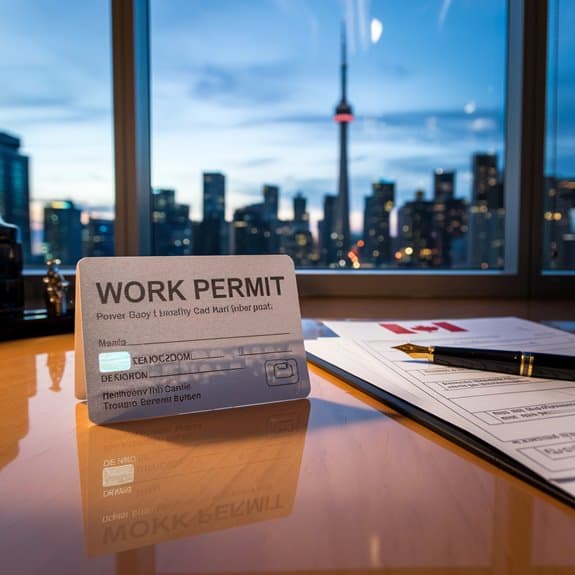
If you’re applying for permanent residence in Canada, a Bridging Open Work Permit (BOWP) lets you continue working while your application is processed. You’ll need valid temporary resident status, an Acknowledgement of Receipt letter for your PR application, and $255 CAD for fees. The permit is typically valid for 24 months and allows work with any employer, though PNP and Quebec applicants face regional restrictions. Your spouse may also qualify for an open work permit under specific conditions. Discover the specific documentation and eligibility criteria to maintain your work authorization in Canada.
Understanding the Bridging Open Work Permit (BOWP)
While seeking permanent residency in Canada, you may find yourself in need of continued work authorization during the processing period. The Bridging Open Work Permit (BOWP) offers a solution, allowing you to maintain legal work status while your permanent residence application is being processed.
A BOWP enables you to work for any employer across Canada, with some restrictions for the Provincial Nominee Program and Quebec applicants.
You’ll need to meet specific eligibility requirements, including having a valid work permit or maintained status, and having submitted your permanent residence application under eligible programs.
The permit typically remains valid for 24 months, though extensions are possible if your PR processing takes longer.
You’ll need to pay a total fee of $255 CAD, which includes both processing and open work permit holder fees.
Key Eligibility Requirements
Meeting the eligibility criteria for a Bridging Open Work Permit requires careful attention to several specific requirements.
You’ll need to be physically present in Canada with valid temporary resident status and have either a current work permit, maintained status from a renewal application, or be eligible for status restoration.
You must have submitted a permanent residence application as the principal applicant under eligible programs like the Federal Skilled Worker Program, Canadian Experience Class, Provincial Nominee Program, or Quebec Skilled Workers.
Your application must have passed the completeness check, and you’ll need proof of this through an Acknowledgement of Receipt letter.
If you’re applying through a PNP or Quebec stream, you’ll also need to provide your nomination certificate or Certificat de sélection du Québec.
Application Process and Documentation
To successfully apply for a Bridging Open Work Permit, you’ll need to gather specific documents and submit your application through IRCC’s online portal.
Applying for a Bridging Open Work Permit requires careful document preparation and submission through IRCC’s online system.
Before starting your application, make sure you’ve received your Acknowledgement of Receipt (AOR) letter from IRCC confirming your permanent residence application.
Your application package must include:
- A valid passport with sufficient remaining validity
- Proof of current status in Canada, such as your existing work permit
- Completed application forms and proof of payment for the $255 processing fee
Once you’ve gathered all required documents, you’ll submit them through your IRCC secure account.
Processing typically takes 3-4 months, and you can continue working under maintained status while awaiting a decision if you’ve applied before your current permit expires.
Fees and Processing Times
The financial investment for a Bridging Open Work Permit consists of two separate fees: a $155 processing fee and a $100 open work permit holder fee, totalling $255 CAD.
You’ll need to pay these fees when submitting your application, and they’re non-refundable regardless of the application’s outcome.
The processing time for a Bridging Open Work Permit typically ranges from 3 to 4 months, though this can vary depending on application volumes and other factors.
During this waiting period, you can continue working under maintained status if you’ve applied before your current work permit expired.
If you need to track your application’s progress, you can do so through your IRCC secure account, where you’ll receive updates about your application’s status.
Provincial and Quebec-Specific Considerations
While Bridging Open Work Permits generally allow holders to work anywhere in Canada, specific restrictions apply for Provincial Nominee Program (PNP) applicants and Quebec-bound workers.
If you’re a PNP applicant, you’ll need to work within the province that nominated you. For Quebec-bound workers, your work must be based in Quebec if you’re applying as a Quebec-selected skilled worker. These restrictions guarantee alignment with regional immigration objectives and local labour market needs.
Key points to remember about provincial restrictions:
- PNP nominees must maintain employment in their nominating province.
- Quebec-selected skilled workers can only work within Quebec’s borders.
- Your work permit will explicitly state these geographic limitations.
Be sure to comply with these requirements to maintain your status and avoid complications with your permanent residence application.
Duration and Extension Options
Understanding time limits for Bridging Open Work Permits helps you plan your work and immigration journey effectively. You’ll typically receive a BOWP valid for 24 months, though this duration can’t exceed your passport’s validity date. If your PR application processing extends beyond the initial period, you can apply for 12-month extensions.
| Duration Type | Details |
|---|---|
| Initial Period | Up to 24 months |
| Extension | 12 months |
| Maximum Length | Until PR decision |
| Limiting Factor | Passport validity |
You’ll need to monitor your BOWP’s expiry date and apply for an extension before it expires to maintain your status. If you don’t receive your PR decision before your BOWP expires, you can request an extension as long as your PR application remains in process.
Work Rights and Restrictions
Bridging Open Work Permits grants foreign nationals substantial employment flexibility across Canada, allowing them to work for almost any employer without requiring a Labor Market Impact Assessment (LMIA).
However, you’ll need to be aware of certain location-based restrictions that may apply to your situation.
There are three main considerations regarding your work rights:
- If you’re a Provincial Nominee Program applicant, you can only work within your nominating province.
- If you’re a Quebec-selected skilled worker, you’re restricted to working within Quebec.
- If you’re applying under other programs like Express Entry, you can work anywhere in Canada.
You’ll maintain these work rights until your permit expires, even if your permanent residence application is refused unless immigration officials specifically revoke your permit.
Family Member Provisions
Foreign nationals who hold a Bridging Open Work Permit can extend their status benefits to their immediate family members through specific provisions.
If you’re working in a skilled occupation (NOC 0, A, or B), your spouse or common-law partner can apply for an open work permit that allows them to work for any employer in Canada.
Your dependent children aren’t eligible for work permits through your BOWP status, but they can apply for visitor records to maintain their legal status in Canada.
To include family members, you’ll need to provide additional documentation, such as marriage certificates or proof of common-law relationships.
Your spouse’s work permit application must demonstrate that you’re employed in an eligible occupation and that you’ll be authorized to work for at least six months after your application.
Frequently Asked Questions
Can I Start My Own Business While on a Bridging Open Work Permit?
You can start your own business while on a bridging open work permit since it’s an open permit that allows you to work for any employer or be self-employed in Canada.
What Happens if I Lose My Job During My Bridging Permit Period?
You don’t need to worry about losing your job since a bridging open work permit lets you work for any employer in Canada. You can immediately look for another job without restrictions.
Can I Study Part-Time While Working on a Bridging Permit?
You can study part-time while working on your bridging permit without needing an additional study permit, as long as your courses don’t exceed 6 months in duration.
Do I Need to Inform IRCC if I Change Employers?
You don’t need to inform IRCC when changing employers on a bridging open work permit since it allows you to work for any employer in Canada, except for PNP and Quebec-specific cases.
Can I Work in Healthcare or Childcare Positions With a Bridging Permit?
You can work in healthcare or childcare positions with your bridging permit, but you’ll need to complete any required medical exams and obtain necessary sector-specific certifications or licenses first.
Conclusion
If you’re pursuing permanent residence in Canada, a BOWP can help you maintain continuous employment while awaiting your PR decision. You’ll need to meet specific eligibility criteria and submit proper documentation to secure this temporary permit. Remember to evaluate the processing times, fees, and any provincial restrictions that may apply. Understanding and following the correct application procedures guarantees you’ll maintain your legal work status throughout your immigration journey.

We serve ALL of Canada. Currently have offices Western Canada — Vancouver, Calgary, Edmonton, Kamloops and Red Deer. We also have the infrastructure to work with any of our clients virtually — even from the furthest regions of the Yukon to Newfoundland.
Call (778) 331-1164 [toll free 1 (844) 715-0940] to get routed to the best office for you or contact us online to schedule an appointment.
We also have a dedicated intake form to help you get the ball rolling. Our intake team will review your specific case and advise you on the next steps to take as well as what to expect moving forward.
Our offices are generally open 8:30 a.m.—4:30 p.m., Mon—Fri.

Alfonso Chen
IMMIGRATION LAWYER
Alfonso is a lawyer of our Vancouver office who provides services in both English and Mandarin. Prior to joining our firm, he worked at a full-service law firm for over four years, where he helped clients with a wide variety of family law matters, from drafting prenuptial agreements to negotiating terms for and drafting separation agreements to representing clients for divorces.



